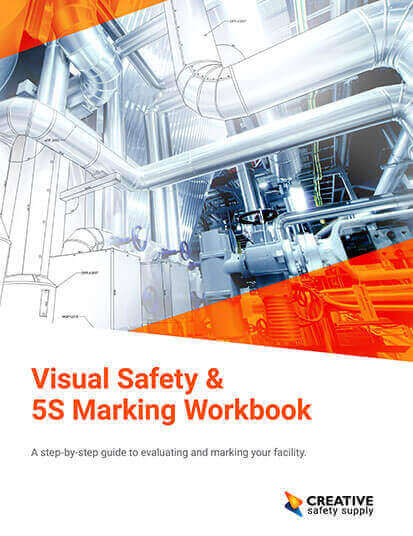
Floor and Aisle Marking
Floor marking tape is a simple but effective tool that can help you create a safer and more productive work environment. Floor marking tape is a type of adhesive tape that comes in various colors, shapes, and sizes, and can be applied to different surfaces and objects in your workplace to convey important information. Floor marking tape can help you:
Identify hazards and risks
Floor marking tape can help you mark potential hazards and risks in your workplace, such as slippery floors, electrical wires, sharp edges, or moving parts. By using colors or symbols that indicate the level of danger, you can alert your workers and visitors to be cautious and avoid accidents. For example, you can use red tape to mark fire extinguishers, emergency exits, or stop signs; yellow tape to mark caution areas or obstacles; or black and yellow striped tape to mark hazardous materials or equipment.
Designate work zones and traffic flow
Floor marking tape can help you designate different work zones and traffic flow in your workplace, such as production areas, storage areas, loading docks, or aisles. By using colors or shapes that indicate the function or purpose of each zone, you can organize your workspace and optimize your workflow. For example, you can use green tape to mark finished goods or quality control areas; blue tape to mark raw materials or inventory areas; or white tape to mark general purpose areas or pathways.
Provide directions and instructions
Floor marking tape can help you provide directions and instructions in your workplace, such as arrows, numbers, letters, or words. By using clear and concise messages that indicate the action or location, you can guide your workers and visitors to navigate your workplace and perform their tasks efficiently. For example, you can use arrow-shaped tape to mark the direction of traffic or movement; number-shaped tape to mark the sequence of steps or processes; or word-shaped tape to mark the name of a zone or a machine.
Enhance communication and visual management
Floor marking tape can help you enhance communication and visual management in your workplace, such as labels, signs, charts, or boards. By using visual cues that display relevant information or data, you can communicate with your workers and visitors effectively and monitor your performance and progress. For example, you can use label-shaped tape to mark the identification or specification of a product or a tool; sign-shaped tape to mark the status or condition of a machine or a process; or chart-shaped tape to mark the goals or metrics of a project or a team.
By using floor marking tape in these ways, you can improve safety and productivity in your workplace. Floor marking tape can help you prevent injuries and errors, reduce waste and downtime, increase quality and output, and foster a culture of continuous improvement. However, to achieve these benefits, you need to follow some best practices when applying floor marking tape:
Conduct a workplace assessment
Before you start applying floor marking tape, you need to assess your current workplace and identify the areas that need improvement. You can use tools such as 5S, Gemba walks, or Kaizen events to evaluate your workplace and find out what information is missing, unclear, or outdated. You should also involve your workers in the assessment process and get their feedback and suggestions.
Choose the right floor marking tape products
There are many types of floor marking tape products available in the market, such as vinyl tape, carpet tape, hazard tape, clear tape, custom tape, etc. You need to choose the products that suit your needs and preferences. Some factors to consider are durability, visibility, ease of installation and removal, cost-effectiveness, and compliance with standards and regulations.
Follow a color-coding system
One of the best ways to make your floor marking tape more visual and effective is to use a consistent color-coding system throughout your workplace. Color-coding can help create contrast, highlight important information, and reduce confusion. You can use colors to indicate different types of hazards, work zones, equipment status, inventory levels, etc. You can follow the standard color codes recommended by OSHA or ANSI, or create your own custom color scheme based on your specific needs.
Use clear and concise messages
Another important aspect of floor marking tape is the content of the messages that you display on your labels, signs, charts, etc. You need to make sure that your messages are clear, concise, accurate, and relevant. You should avoid using jargon, abbreviations, or acronyms that might confuse your workers or visitors. You should also use simple and easy-to-understand symbols or pictograms whenever possible to supplement or replace text.
Review and update your floor marking tape regularly
Floor marking tape is not a one-time project; it is an ongoing process that requires regular review and update. You need to monitor the condition and effectiveness of your tape and replace or repair it as needed. You also need to keep up with any changes in your workplace layout, processes, equipment, or regulations that might affect your floor marking tape. You should conduct periodic audits and inspections to ensure that your floor marking tape is always up-to-date and compliant.
By following these best practices, you can use floor marking tape to improve safety and productivity in your workplace. Floor marking tape can help you create a visual workplace that enhances communication, organization, and efficiency in your organization.
Similar Questions
- What are the Benefits and Best Practices of using Color-Coding for labels and signs in Facility Marking?
- How does proper Facility Marking help create a more Safe and Visual Workplace?
- What are the Best Facility Marking Techniques?
- What is Facility Marking?
- How does Facility Marking Improve Safety Awareness and Navigation?
- How can I prevent Warehouse Accidents with Facility Marking?
- What are the Best Practices for Installing and Maintaining Facility Marking Products?

